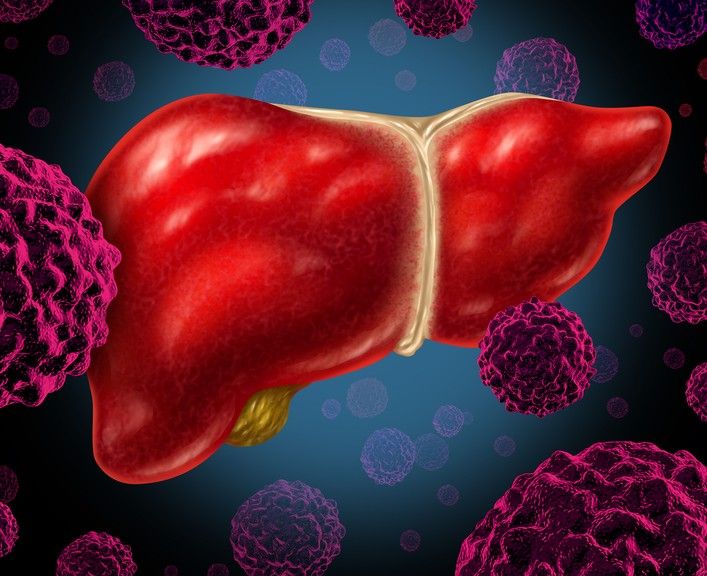
Previous
Probiotics and Synbiotics Battle Fat in the Liver

Next
8 Great Foods for Detoxing the Liver
Liver Cancer Thwarted by Specialized Radiation
Only certain individuals will qualify, but stereotactic body radiation therapy represents a substantial improvement in liver cancer treatment.
Nobody wants his or her fight against chronic liver disease to include liver cancer, yet over 33,000 new cases are estimated to emerge this year in the U.S. In the past, liver cancer had generally been associated with a relatively grim prognosis. Today, advancements in Western medicine have greatly improved the odds of surviving liver cancer. Conventional radiation is an accepted treatment component for many types of cancers despite its potential for side effects and mediocre success rate. However, a highly specialized type of radiation called stereotactic body radiation therapy (SBRT) is safer than its conventional cousin and is dramatically raising the liver cancer cure rate.
Comparing SBRT to Conventional Radiation
Also known as stereotactic ablative radiotherapy, stereotactic body radiation therapy is a type of treatment in which a few, very high doses (5 to 10 times the typical daily dose) of radiation are delivered to small, well defined tumors. “At the high dose, radiation is much more effective at killing cancer than when you break it up into smaller doses,” says Dr. Kenneth Rosenzweig, chair of the department of radiation oncology at Mount Sinai.
If the patient’s cancer qualifies them to be treated with SBRT instead of conventional radiation, there are several advantages:
- Conventional radiation is delivered daily in relatively small doses over the course of several weeks.
- SBRT is typically delivered in a single high dose or in a few fractionated radiation treatments (usually up to 5 treatments within one week).
- Two-year success rates for conventional radiation range from 30 to 40 percent.
- Two-year success rates for SBRT range from 80 to 90 percent.
- Conventional radiation beams are typically within a half-inch to an inch of the targeted tissue.
- SBRT radiation beams are typically within two millimeters of the targeted area, reducing radiation’s impact on healthy tissue.
- Conventional radiation can be associated with severe side effects including radiation pneumonia.
- SBRT is associated with far fewer side effects, most commonly slight fatigue for one week following treatment.
How SBRT Works
There are several steps involved with SBRT that are unique:
- Before beginning SBRT, four-dimensional imaging of the area in need of treatment must be mapped as it moves with the patient’s breathing cycle.
- Gold seeds, called fiducials, are usually implanted into the tumor prior to this imaging to increase visibility and ensure accuracy.
- Radiation oncologists work with medical physicists to develop a radiation plan that ensures safe exposure to normal structures.
- Patients typically receive a custom mold to help them keep perfectly still during the treatment.
- Each treatment session takes 30 to 60 minutes and ends without significant pain or side effects.
SBRT for Liver Cancer
High doses of radiation therapy are currently only applicable to situations where there are very small tumors, a condition that makes SBRT ideal for some types of liver cancers. Because it’s commonly diagnosed early, liver cancer is frequently detected while the cancer is still small.
Chronic liver disease – especially chronic Hepatitis B and Hepatitis C – are the leading causes of liver cancer. Thus, patients with these ailments usually undergo routine analysis to screen for developing liver cancer. These screenings catch liver cancer earlier than many other types of cancer.
For most liver tumors, the first and ideal treatment option is surgery. Unfortunately, many people are not good candidates for surgical resection of the cancerous liver tissue. This can be due to age, the size and location of the cancer or other medical complications. An increasing number of physicians are considering SBRT for those with liver cancer who are not candidates for surgery.
- In a University of Michigan study published in a 2013 edition of the journal Translational Oncology, researchers concluded that SBRT provides excellent local control for both primary and metastatic liver lesions with minimal toxicity.
- In an Italian-led review spanning 10 years that was published in a 2014 edition of the Journal of Gastrointestinal Oncology, researchers concluded that SBRT is a non-invasive, well-tolerated and effective treatment for patients with liver metastases not suitable for surgical resection.
Stereotactic body radiation therapy is not a wide-spectrum magical cure. The high dose of radiation limits its use. Nonetheless, liver cancer that is caught early AND is inoperable might qualify a patient for this potent treatment. Characterized by a shorter regimen, fewer side effects and better success rates, stereotactic body radiation therapy represents a major breakthrough in liver cancer treatment.
http://radonc.ucla.edu/body.cfm?id=349, FAQs: SBRT, Retrieved August 24, 2014, UCLA, 2014.
http://www.cancer.org/cancer/livercancer/detailedguide/liver-cancer-treating-by-stage, Treatment of Liver Cancer by Stage, Retrieved August 24, 2014, American Cancer Society, Inc., 2014.
http://www.cancer.org/cancer/livercancer/detailedguide/liver-cancer-what-is-key-statistics, What are the Key Statistics About Liver Cancer?, Retrieved August 24, 2014, American Cancer Society, Inc., 2014.
http://www.ncbi.nlm.nih.gov/pmc/articles/PMC3730019/, Stereotactic Body Radiation Therapy for Primary and Metastatic Liver Tumors, Liu, E, et al, Retrieved August 24, 2014, Translational Oncology, August 2013.
http://www.ncbi.nlm.nih.gov/pmc/articles/PMC4074953/, Stereotactic body radiation therapy for liver metastases, M Scorsetti, et al, Retrieved August 24, 2014, Journal of Gastrointestinal Oncology, June 2014.
http://www.nydailynews.com/life-style/health/daily-checkup-sbrt-lung-liver-cancers-article-1.1900877#ixzz3BLhDqJuV, Daily Checkup: SBRT is an excellent option for treating lung and liver cancers, Katie Charles, Retrieved August 24, 2014, NYDailyNews.com, 2014.






